The Best Greenhouse Floor Options for Growers [7 different options]
As a grower, you want a constant good quality plant to be (and stay) a reliable partner for your customers. To reach this goal, you need to have the right greenhouse floor. There is are different kinds of greenhouse flooring. But which one is right for you? On this page we explain everything. Do you prefer a call to sales? Click here.
We compare 7 different greenhouse floors (indoor/Outdoor) for your nursery. We explain more about the differences below.

This page offers a wealth of information. Use the links below to navigate directly to the subjects you are interested in.
- What is the best greenhouse flooring solution?
- Greenhouse flooring topics: Water Management, drainage and prevention of puddles.
- Greenhouse flooring topics: Climate Control and Heating/Cooling Systems.
- Greenhouse flooring topics: Flexibility and Plant Growth.
- Greenhouse flooring topics: Cost Analysis and Return on Investment.
- Greenhouse flooring topics: Automation and Labor Efficiency.
- Greenhouse flooring options: Employee Experience and Work Pleasure.
- Effect of the floor inside and outside the greenhouse on diseases
- Comparing the different greenhouse flooring options.
- How to choose the right greenhouse floor for your situation?
- Greenhouse Flooring innovations
- Greenhouse floor in combination with greenhouse irrigation system
- How to keep your greenhouse floor free from diseases
Uneven plant growth effects your business as grower
Imagine the frustration of nurturing your plants with care and dedication, only to see uneven growth patterns and varying quality across your greenhouse. You strive for excellence, but inconsistent watering and drainage caused by traditional flooring methods disrupt your efforts. This not only impacts your plants' health but also leaves you grappling with unnecessary water wastage and escalating operational costs.
Furthermore, you aspire to diversify your plant offerings and respond to market demands, but limited flexibility in your flooring options holds you back. It's essential to have a flooring solution that accommodates various plant types and pot sizes, empowering you to seize new opportunities in the market.
Customer story of ErfGoed.
Intro: Challenges for growers: greenhouse floor as a possible solution
Imagine the frustration of nurturing your plants with care and dedication, only to see uneven growth patterns and varying quality across your greenhouse. You strive for excellence, but inconsistent watering and drainage caused by traditional flooring methods disrupt your efforts. This not only impacts your plants' health but also leaves you grappling with unnecessary water wastage and escalating operational costs.
Furthermore, you aspire to diversify your plant offerings and respond to market demands, but limited flexibility in your flooring options holds you back. It's essential to have a flooring solution that accommodates various plant types and pot sizes, empowering you to seize new opportunities in the market.
You must make strategic decisions regarding cultivation methods and systems to address these issues:
- Maximizing Yield Efficiency: Growers need to enhance returns, reduce costs, and optimize space utilization. They aim to accelerate growth, increase plant yields, and quickly deliver uniform, high-quality products.
- Enhancing Resilience and Quality: Adjusting to reduced crop protection products and cultivating robust, disease-resistant plants in ideal conditions are priorities. The market demands high-quality products. More than a 7 is required; buyers expect at least a 9.
- Automation vs. Ideal Plant Conditions: Balancing labor scarcity with automation decisions is essential. Growers must choose between concrete floors for automation and to provide ideal plant growth conditions.
- Cost control: With escalating costs in labor, energy, and raw materials, growers must operate at the cutting edge. Efficiently managing water and fertilizer inputs is crucial to reduce waste and expenses.
- Coping with Weather Extremes: Dealing with extreme weather conditions, like droughts and heavy rainfall, is a growing concern. Proper water collection and data analysis regulation is essential for developing effective strategies.
- Staying Flexible: Adapting to rapidly changing market demands and diversifying production is key. Entrepreneurs need to adjust layouts and practices to maintain flexibility and secure future prospects.
A greenhouse floor contributes to the solution!
You might not immediately expect it, but a cultivation floor can contribute to a solution for the issues or challenges mentioned. It is, of course, important to choose the right floor. You find below more answers on how the floor contributes to these challenges.
Different greenhouse flooring solutions (outdoor/indoor)
There are several greenhouse flooring solutions for inside and outside (Concrete Floors, Benches, Dutch Container Systems, Crushed Stones, ErfGoedFloor Excellent and ErfGoedFloor Premium) It depends on you situation what the best flooring option is. On this page, we discuss the different flooring options and important themes for growers. We're answering these questions.
- What is good flooring for a greenhouse?
- What is the cheapest greenhouse flooring?
- What kind of floor do you use for a greenhouse?
- What is the best floor for a greenhouse?
1. What is the best type of flooring for a greenhouse?
The best greenhouse floor for you depends on your specific needs and goals. If your aim is to achieve consistent and top-quality plant growth, look no further than the ErfGoedFloor Excellent – the ultimate greenhouse flooring option. With its innovative ebb-and-flow system, sustainable materials, and efficient water distribution, this flooring solution is designed to optimize plant health and yield.
However, selecting the best greenhouse flooring involves considering various factors. In the following sections, we will delve into different situations and options to help you make an informed decision. Explore the table below to see how we score the various greenhouse flooring choices for your specific needs. Elevate your cultivation process with the perfect flooring solution for your greenhouse.
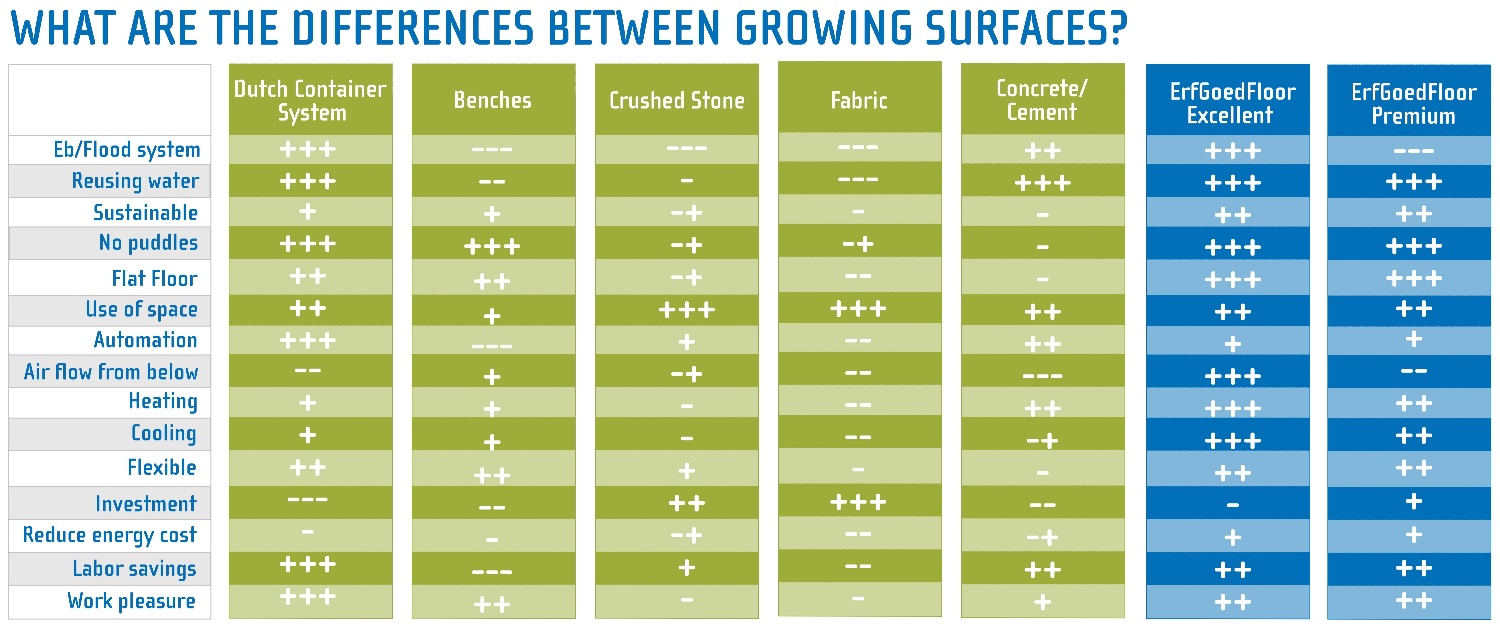
Do you want the explanation of this scheme? Please download the whitepaper for free.
To understand the table it is good to understand how we interpret the definitions of the different floors solutions.
1.1. Crusted Stone
A greenhouse flooring surface composed of crushed stone sourced locally. Typically, it forms a layer approximately 2-6 inches thick, placed over topsoil or subsoil, often covered with fabric to enhance its properties.
1.2. Concrete Floor
These are ebb-and-flow concrete floors found in greenhouses. The floor features a slight slope, allowing water to rise from gutters or wells along the greenhouse's full length, gradually filling the entire floor.
1.3. Benching System
Fixed growing tables found in several greenhouses, usually made of metal or wood and immovable. These tables lack an ebb and flow system and often have an open bottom for drainage.
1.4. ErfGoedFloor Excellent / Ebb - Flood Floor
Among various ErfGoedFloors, this is the most extensive option. It utilizes an ebb-and-flow system capable of cooling and creating air circulation from beneath the surface.
1.5. ErfGoedFloor Premium
This floor type does not incorporate an ebb and flow system. Instead, it consists of foil, drainage, rock, and a ground cloth. It may also offer water buffering capabilities.
1.6. Fabric Floor / Ground Cover
This type of flooring involves woven plastic laid on the ground, often placed over gravel or similar materials. The surface usually allows for drainage, though its specific features may vary depending on the grower's preferences.
1.7. Dutch Container System
These movable benches can be controlled manually or automatically using a computer within the greenhouse. The grow tables under comparison include ebb and flood systems, constructed from aluminum, steel, and feature expanded metal or plastic inserts for the growing surface.
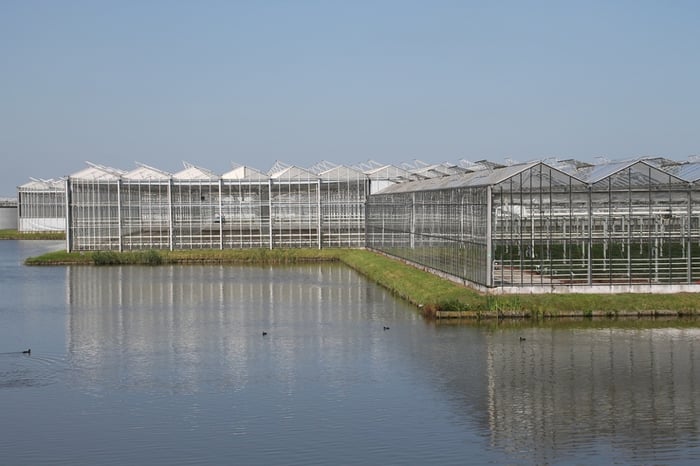
2. Greenhouse floor topics: Water Management, drainage and prevention of puddles
Good water management is a vital aspect that directly impacts plant health, plant quality and overall productivity. Choosing a flooring solution influence: irrigation strategy, water storage (and filtration), drainage, all of which contribute to better plant growth and to a constant quality crop.
2.1. Water Distribution
Greenhouse flooring plays a vital role in water distribution, influencing plant growth and overall efficiency. Dutch Container Systems, Concrete Floors, and ErfGoedFloor Excellent employ distinct methods for water distribution.
The Dutch Container Systems ensure even water distribution through slots in grow tables, providing each plant with the necessary moisture. However, Concrete Floors distribute water from gutters to the plants, resulting in uneven watering. This inconsistency can lead to some plants receiving excess water while others lack sufficient hydration, affecting their growth. In contrast, the ErfGoedFloor Excellent spreads water horizontally through stones, ensuring uniform hydration for all plants, fostering consistent and healthy growth.
The Dutch Container Systems and ErfGoedFloor Excellent offer effective water distribution, supporting thriving plant growth.
2.2. Reusing water: 4 different greenhouse flooring options
Water reuse is becoming increasingly important for greenhouse operations, and many countries are implementing regulations to promote sustainable practices. As a grower, making future-proof decisions is crucial. Choosing a greenhouse flooring solution that facilitates water reuse is a step towards environmental responsibility.
You have four options to consider: Concrete Floors, Dutch Container Systems, ErfGoedFloor Excellent, and ErfGoedFloor Premium. If you're curious about how to effectively clean irrigation water, we have valuable information available for you.
2.3. Prevention of puddles
Puddles on greenhouse floors can lead to uneven plant growth and pose a significant concern for growers. Concrete floors, despite level pouring, are prone to puddling. Ground cloth and crushed stones also perform poorly in this regard. On the other hand, Dutch Container Systems, Benches, and ErfGoedFloors demonstrate score high on preventing puddles, ensuring a more consistent and quality plant growth.
.jpg?width=500&height=362&name=ErfGoed%20AirFlow%20(1).jpg)
3. Greenhouse floor topics: Climate Control and Heating/Cooling Systems
You want to have constant high quality plants, right? Does it frustrate you, that you don't get a grip on the climate of the greenhouse? Greenhouse flooring plays a vital role in climate control and plant health, as it directly affects temperature regulation and moisture retention.
Each flooring option, including the ErfGoedFloor Excellent, concrete floors, Dutch Container Systems, and crushed stone, has distinct heating and cooling capabilities, impacting the overall greenhouse environment and plant well-being. We will highlight the most important points.
3.1. Heating Capabilities
The Concrete Floor, Dutch Container System, ErfGoedFloor Excellent, ErfGoedFloor Premium, and benches all utilize heating pipes to create heating from below. It's worth noting that while concrete floors do incorporate heating pipes, they are generally less efficient at conducting and distributing heat compared to ErfGoed Floors.
3.2. Cooling Capabilities
- ErfGoedFloor Excellent: The ErfGoedFloor Excellent provides an advantage in cooling as growers can use a layer of water beneath the floor for cooling purposes. This cooling from below helps maintain optimal temperature levels for the plants.
- Concrete Floors: Concrete floors can be modified to incorporate cooling systems, but this practice is not widespread. Consequently, their cooling capabilities are often limited compared to the ErfGoedFloor Excellent.
- Dutch Container Systems: While Dutch Container Systems may allow for some cooling, we didn't see it often in practice.
3.3. Climate control with greenhouse floor (new)
Effective air circulation is a critical factor that significantly impacts the consistent quality of plants. We want to enhancing growers' control over their greenhouse climate. One way we are achieving this is by exploring advanced solutions for improved air circulation.
Only ErfGoedFloor Excellent offers this unique functionality. We are excited to announce that we are actively testing a floor with enhanced air circulation capabilities and will soon share detailed information on its benefits. Read here the last update.
Do you want to learn more about microclimate, humidity, airflow, and floor cooling? Read this blog: 'A Resilient Plant Thanks to a Stable Microclimate.'

4. Greenhouse floor topics: Flexibility and Plant Growth
As a grower, choosing the right greenhouse flooring is essential for optimizing the constant quality of your plants to be a reliable business partner for buyers. Assessing the flexibility of each flooring option in accommodating various plant types and pot sizes can greatly impact your overall quality and success.
Concrete floors
Concrete floors provide a stable surface for most plant types and pot sizes. However, they may present challenges for more sensitive plant varieties that require precise water drainage and aeration. It's essential to ensure proper leveling during installation to avoid puddling and uneven watering.
Dutch Container Systems
Dutch Container Systems offer remarkable flexibility, enabling you to cultivate a wide range of plant types and pot sizes. Their movable nature allows easy adjustments, optimizing space utilization in your greenhouse. These systems excel at accommodating various crops, making them a popular choice among growers seeking versatility.
ErfGoed Floor Excellent
ErfGoedFloor Excellent boasts exceptional flexibility, catering to a diverse selection of plant types and pot sizes. With its innovative ebb-and-flow system and air circulation capabilities, it provides an optimal environment for consistent plant growth. This flooring option is well-suited for a wide array of crops, ensuring top-quality yields.
Benches
Benches have limitations in terms of flexibility. While they offer stability and ease of access for certain plant varieties, they might not be the best choice for growing more delicate or diverse crops. However, with careful planning and organization, you can still utilize benches effectively for specific plant types.

5. Greenhouse floor topics: Cost Analysis and Return on Investment
Are you a grower looking for the perfect greenhouse flooring option that fits your budget and delivers long-term cost savings? Let's compare the initial investment costs of various greenhouse flooring options and explore their potential Return on Investment (ROI) in the long run.

5.1. What is the cheapest greenhouse flooring?
Fabric (ground cover) is the cheapest greenhouse floor for growers. However, it's crucial to consider the potential drawbacks. Fabric Floors may require more manual labor, impacting your workforce efficiency. In the long term, the lack of advanced water distribution, heating/cooling systems and flexibility might lead to uneven plant growth and lower yields.
5.2. What is the greenhouse floor with the best ROI?
When it comes to greenhouse flooring, it's essential to look beyond the initial investment costs and consider the long-term ROI and cost-saving potential. Dutch Container Systems and ErfGoedFloor Excellent may require a slightly higher upfront investment, but their automation, water efficiency, and improved plant success rates result in significant savings over time. Make an informed decision based on your specific needs and budget to achieve maximum profitability and success in your greenhouse operation.
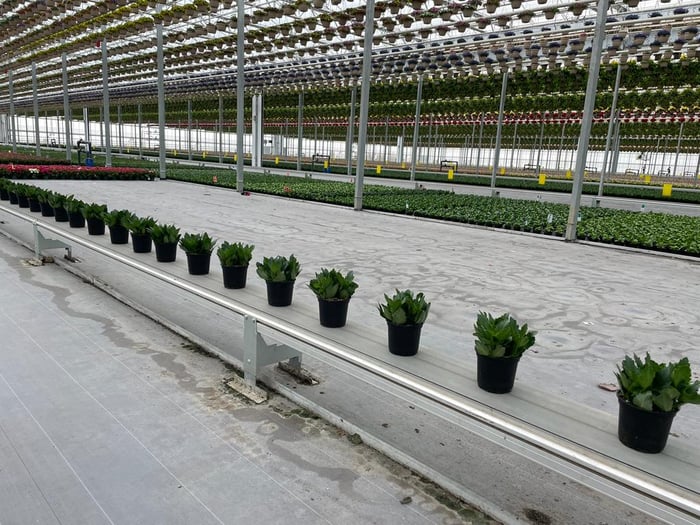
6. Greenhouse floor topics: Automation and Labor Efficiency
When it comes to greenhouse flooring, considering the level of automation and internal transport capabilities is crucial for maximizing labor efficiency and overall productivity.

6.1. The best greenhouse floor for automation
The Dutch Container Systems offer a high level of automation, controlled by computer systems. This feature eliminating the need for manual handling and reducing labor-intensive tasks. The automated process optimizes workflow and ensures efficient plant management. This leads to substantial labor savings.
6.2. Other ways for automation of processes in greenhouses
A concrete floor allows for better drivability compared to an ErfGoedFloor Excellent. However, it's worth noting that an ErfGoedFloor can still be driven on.
In recent years have been significant advancements in internal transport options. Conveyor belts have become common, and innovative technologies like flying forks enable seamless movement of plants from the back of the greenhouse. Additionally, robotization presents exciting new opportunities for automation. Considering these factors alone would yield different results in the comparison of flooring options.
Below is a summery of different automation options:
- Conveyor belts
- Forklift with double pneumatic tires
- Overcrop carts
- Deploy robots
- Trolley Tracks
- Reinforcement plates in the floor
- Pipe rails
- Concrete paths
- Tiles / rubber mats
- Tire trucks
- Steel frames
- Submissive
- Flying Fork
- Betrack
To read more about logistic systems with an ErfGoedFloor, read those blog posts:
- Trolley Path Way and Trolley tracks: When should you choose which logistics solution?
- Growing without additional labor with smart logistics: 3 tips for nurseries
- Choice of conveyor belt type depends on business and cultivation needs
- Fixed conveyor belts bring labor savings, calm, and structure
- A forklift could be the Ideal Internal Transport Solution for Growers
6.3 Automate step by step
Automating your processes has a big impact on your company. Cor Bremmer, commercial director, advises growers to automate step by step. In this blog post, he gives some tips and tricks to automate smartly.
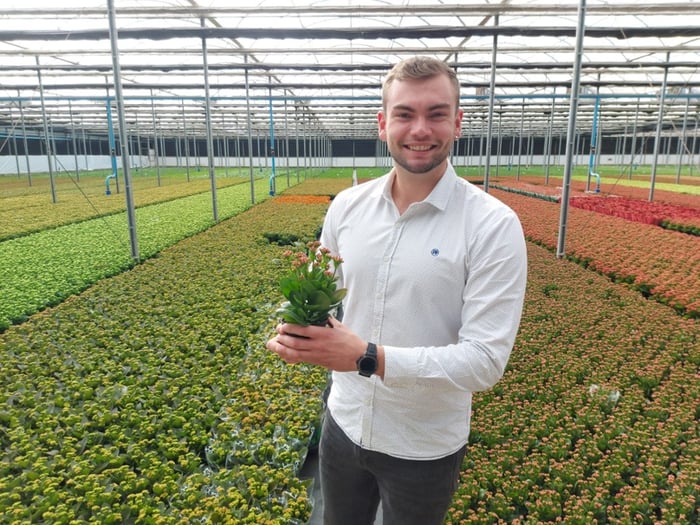
7. Greenhouse floor topics: Employee Experience and Work Pleasure
The Dutch Container System provides employees with a workplace at a perfect height. This is very pleasant. In addition, a good working environment can be created in the headhouse, so employees do not have to go into the hot greenhouse. Benches don’t give employees a good working environment (climate), but they can work at a perfect height. The Concrete Floor and ErfGoedFloor provide employees with a clean workplace because the surface is not wet. In addition, the ErfGoedVloer Excellent is softer, making it more pleasant to walk on.
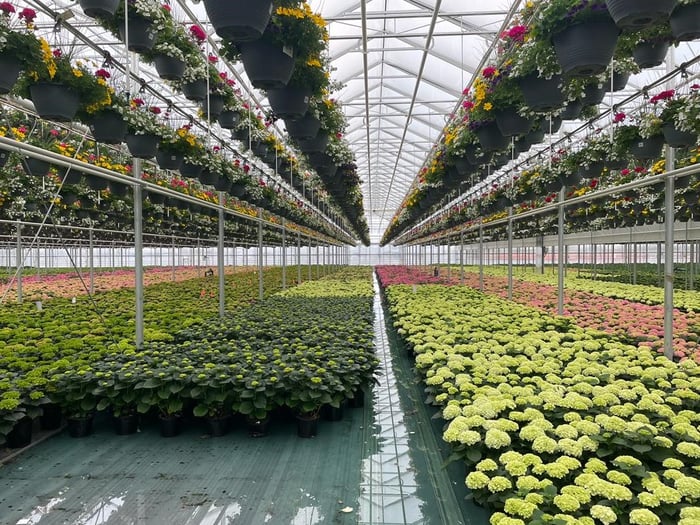
8. Effect of the floor inside and outside the greenhouse on is fungus
Fungi could give you big problems. You do a lot to keep fungi away. We interviewed a horticultural specialist in the Netherlands to give some advice to growers. In this blog post, he shares his views on fungi. But what is the effect of the greenhouse floor on fungi?
8.1. Prevent Excessively Wet Soil
When you use an ebb and flow system, it is easier to control the moisture instead of overhead irrigation. It is also important to prevent your plants from puddles. These are the elements you need to know when you want fewer chances of fungi in your plants.
8.2. Plant Health
A strong and healthy plant is better protected from fungi than weak plants. For example, you could buy a cheap floor with more risk of weak plants and fungi, or you could choose a more expensive floor with less chance of fungi. It depends on your strategy.
Read here more about root rot. Do you want more tips about plant resilience? Click here.
9. Comparing best greenhouse floors: Benching System, Concrete Floor, ErfGoedFloor and Dutch Container System
So you understand the definitions of the different greenhouse flooring. You saw also the table with the different comparisons (if not click here).
We wrote a few blogs post about the comparisons. It helps you to see want for your situation is relevant.
- Ground Cover versus ErfGoedFloor: the 7 main differences
- Dutch Container Systems versus an ErfGoed Floor: the 7 main differences
- Concrete floor versus ErfGoedFloor - The 12 most important points!
- Benches versus ErfGoedFloor: the 7 main differences
9.1. Different ErfGoed Flooring options
We have three different options. You will find here an overview. And click on the links below to find specific information.
9.2. Greenhouse floor covering - ErfGoed
We offer various types of greenhouse floor coverings, with the primary distinctions being in black and grey options.
The grey covering provides superior light reflection, which helps to maintain a cooler temperature on the floor. Additionally, it boasts improved water permeability. On the other hand, the black covering offers enhanced UV protection.
Furthermore, we provide options for covers with fire-resistant properties.
-1.jpg?width=700&height=525&name=P1030071%20(1)-1.jpg)
10. How to choose the right greenhouse floor for your situation?
When investing in a new greenhouse floor or environment, maximizing return on investment and aligning with your business processes and future ambitions are essential. Here are some key success factors to consider:
10.1. Company goals
Begin by evaluating your specific requirements and objectives. Consider factors such as the type of crops you plan to grow, the size of your greenhouse, the climate conditions in your region, and your budget constraints.
Besides that, what do you want to achieve? Do you aim for high and consistent plant quality to become a reliable supplier for your buyers? Or do you prioritize cost efficiency and automation?
10.2. Logistics Optimization
Review your company's logistics lines and processes when choosing a new greenhouse floor or cultivation system. Minimize walking distances and ensure efficient crop protection operations. Make clear choices to increase overall efficiency.
10.3. Water Storage Capacity
Investing in a new floor or system often requires a water storage basin or silos. Ensure the storage capacity is suitable to maintain sufficient irrigation water at all times. Consider drought periods and future climate developments for proper sizing.
10.4. Hours of Watering per Day
Determine the maximum hours of watering per day based on crop requirements and preferences. This influences pump capacity and pipe size decisions.
10.5. Diversity of Fertilizer Recipes
Map out the number and variation of fertilizer recipes you intend to use. Separate collection of return water with different nutrient compositions is crucial. Reusing nutrient-rich return water optimally benefits plant growth.
10.6. Future Nursery Plans
Consider future expansion and changes to your crop assortment. Future plans can impact basin or silo size, fertilizer choices, and placement of connections. Align your choices with your long-term goals.
The ErfGoed Masterplan is a valuable resource to help you clarify these considerations and make informed decisions for a successful greenhouse flooring investment. You could read more about a featured plan for your greenhouse here.
11. Greenhouse Flooring innovations
We are always looking for new innovations to improve the greenhouse floor for your plants. A new innovation we are working on is the Airflow System. It could help provide better control over the temperature in your greenhouse. You can learn more about the initiative here.
12. Greenhouse floor in combination with greenhouse irrigation system
The greenhouse floor is often connected to the irrigation system. Some floors provide water and/or collect irrigation water, which is why we believe the connection between the two is very important. That's why ErfGoed delivers both systems to growers. You can learn more about this on this page.
13. How to keep your greenhouse floor free from diseases
The last thing you want is disease. That’s why it’s important to keep your floor clean. We have created a hygiene protocol for the ErfGoedFloor, which includes Preventive Measures (when installing a floor and before starting a crop) and Curative Measures (after the end of a cultivation). The preventive measures include the following:
- Minimize contamination in the greenhouse
- Right Water Management
- Sand Filter and Sieve Bends
- Ensure Sufficient Oxygen in the Water
- Water Disinfection with Cleaning Agents
- Covering the Basin/Silo
- Monitoring Water Quality
The Curative Measures concludes:
- Step 1. Remove plant and substrate residues
- Step 2. Let the floor dry
- Step 3. Cleaning with Sweeping and Vacuuming Machine
- Step 4. Rehydration of the floor
- Step 5. Clean with a patio cleaner
- Step 6. Post-treatment with a cleaning agent
- Step 7. Monitoring




